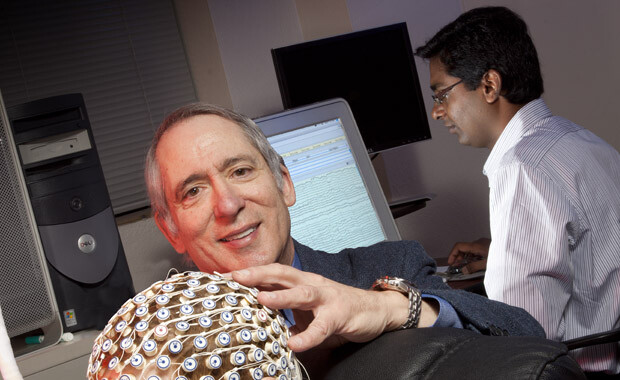
Dennis Molfese, director of the UNL’s Center for Brain, Biology and Behavior, is one of 14 authorities who served on a National Academy of Sciences committee that investigated sports-related concussions in youth.
The Committee on Sports-Related Concussions in Youth released its report Oct. 30 at an event in Washington, D.C. Citing a “culture of underreporting,” the committee called for a national surveillance system to monitor how often sports-related concussions occur in youth ages 15 to 21; longitudinal studies of the short-term and long-term consequences of concussions; and more research into equipment improvements and rules changes that could reduce the risk of concussions among young athletes.
The report is available at http://go.unl.edu/y6f9.
The committee’s most sobering finding, Molfese said, is that much remains unknown about concussions, their diagnosis and treatment.
“Many policies surrounding concussion are not based on scientific research,” Molfese said. “We need a great deal more information before conclusions can be reached” about how to prevent and treat concussions, he said.
For example, rest is commonly prescribed to recuperate from a concussion, Molfese said. But no research definitely indicates how long a student-athlete ought to stay off the field or out of the classroom. In fact, staying out of the classroom could slow the brain’s recovery and result in an academic setback.
Another common yet unsubstantiated belief is that helmets protect against a concussion, he said. Helmets protect against skull fractures, but not against the whiplash effect that causes concussion.
“Hit counts” – tracking how often an athlete experiences a blow to the head – aren’t useful predictors of future concussions, though the risk of long-term disability increases with each concussion and it is believed that “sub-concussive blows” may increase the risk of brain damage.
Concussions today are diagnosed through symptoms, such as headaches, nausea, disorientation, gait and balance problems, Molfese said. CT and MRI scans don’t detect damage to the brain from concussions. It is not clear whether a person “recovers” from a concussion. Instead of returning to its previous function, the concussed brain may have restructured itself to compensate for the damage, he said.
Molfese said the committee’s investigation makes it clear that concussions should not be taken lightly.
“Concussion is a serious injury. Concussion is brain damage,” he said.
In addition to Molfese, members of the Committee on Sports-Related Concussions in Youth include Robert Graham, George Washington University, chair; Frederick P. Rivara, University of Washington, vice chair; Kristy Arbogast, Children’s Hospital of Philadelphia; David A. Brent, University of Pittsburgh; B.J. Casey, Weill Cornell Medical College; Tracey Covassin, Michigan State University; Joe Doyle, USA Hockey; Eric J. Huang, University of California, San Francisco; Art C. Maerlender, Dartmouth College; Susan Margulies, University of Pennsylvania; Mayumi L. Prins, University of California, Los Angeles; Neha P. Raukar, Brown University; Nancy R. Temkin, University of Washington; Kasisomayajula Viswanath, Harvard School of Public Health; Kevin Walter, Medical College of Wisconsin; and Joseph. L. Wright, Children’s National Medical Center.
30WRITER: Leslie Reed, University Communications







